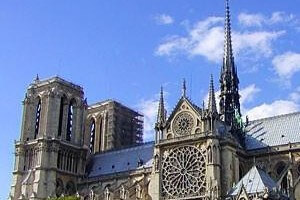Lately we’ve heard a lot about the Notre Dame scandal. Given this month of May is devoted to Our Lady (Notre Dame in French, you’ll remember), we ought to turn our attentions from South Bend, Indiana to Paris – to the “other” Notre Dame, that famous cathedral that has stood in the heart of Paris for more than 800 years. Dedicated to the Blessed Virgin it has served as the silent witness to the tumultuous history of France. It is known to Parisians as “the Bible in Stone.” In the manner of the best Gothic cathedrals of the era, it displayed all the knowledge that was needed for life and salvation.
In his novel about that famous hunchback Quasimodo, Victor Hugo once wrote of the great cathredal: “Every face, every stone of the venerable monument is a page not only of the history of France, but also of the history of art and science. Notre Dame Cathedral has stood throughout the centuries and witnessed the many changes around her. Just think: the Crusades were preached. Mary, Queen of Scots was married. Napoleon was crowned. Joan of Arc was beatified. Charles de Gualle celebrated the liberation of Paris from the Nazis in 1944. All here at Notre Dame Cathedral.
The Cathedral stands on the eastern end of an island in the Seine River called the Ile de la Cité (City Island). Its grounds have been considered sacred since well before the present cathedral was built. Celtic tribes first built wood and reed tabernacles to pagan gods here. Later the Romans who conquered the French lands built a temple to Jupiter. The first Christian church was built on this site in the 4th Christian century; and in the 6th century a basilica was built, the first that was dedicated to the Blessed Virgin.
On this same spot in A.D. 1160, the Bishop of Paris, Maurice de Sully drew on the ground with his crosier the outlines of Notre Dame, considered the first true Gothic cathedral. Bishop de Sully devoted the rest of his life and all of his personal fortune to building the monumental church. His will even paid for the expense of having the roof covered with lead.
During his lifetime the roofless ruin of the old church, called St. Etienne, served as the workshop for the new cathedral. It stood next to the new building. Stone was carved here. All manner of artist’s and craftsman’s tools along with materials—glass, stone, timbers, sand—crowded the workshop as the laborers worked long hours, some of them their entire lifetime, to make progress on the cathedral. The workshop was a veritable city in and of itself. It became the home to many of the workers—who worked, ate, and slept there. Eventually St. Etienne had to be torn down to make way for the nave of the new cathedral.
In 1163 Pope Alexander III, accompanied by Bishop de Sully, King Louis VII and all the clergy and nobles of Paris, consecrated the new Cathedral under the patronage of the Blessed Virgin Mary. For the next 140 years the church saw workers from many generations laboring on the great cathedral.
The original scheme was a pure Gothic structure, but as the decades passes the Gothic went out of style. By the 15th century the cathedral’s architecture was considered outdated. The Renaissance had begun; and men of the new age looked on the Gothic structures of the past as symbols of grotesque barbarism. Later, Baroque additions upset the original Gothic design and destroyed the inherent beauty of the Gothic cathedral.
The pilgrimages that had been encouraged wihile the cathedral was being built, to raise funds for the workers and materials, continued on as a tradition for the centuries following. Those Catholics who lived in or near Paris, much of the population of France at the time, made an annual pilgrimage to the Church of Our Lady
Students from the University of Paris, a renowned institution by then, paid a formal visit each year to Notre Dame. Individual students made a habit of coming there regularly to pray. Many especially made their pilgrimages on Saturdays, a day traditionally devoted to Our Lady.
In times when floods from the Seine threatened the city of Paris, or when droughts and sicknesses threatened Parisians, they took to the streets around the cathedral. The beautiful shrines and reliquaries made of crystal, gold, enamel and ivory were brought out of the church. Great crowds then processed with the relics down the streets of Paris in prayer, dedicating themselves and their city to the protection of the Virgin Mary and her Son.
In 1831 writer Victor Hugo published the novel, Nortre Dame de Paris. In this book he glorified architecture as a living history. Hugo regarded Notre Dame as “a book in stone.” He criticized what Parisians of the 18th century had done to the great cathedral in the name of fashion. He drew up a list of the criticisms: the colored stained-glass windows were gone, the interior was white-washed (everything painted white), the tower over the central part of the cathedral had been ripped off, the shape of the central entrance to the Cathedral had been deformed, the chapels were filled with ugly decorations.
Inspired by this novel, Eugene Emmanuel Violet-le-Duc drew up a plan to restore the cathedral to its original plan. He recreated the stained-glass windows by copying other stained glass from the cathedrals in other French cities which had escaped the destruction of the 18th century. He also replaced all the sculptures of Notre Dame which had been smashed during the years of the French Revolution. Violet-le-Duc researched the pictorial records of other French Gothic cathedrals. He designed a new tower, called a fleche, to top off the crossing of the cathedral as it had once been. He also restored the great doors of the cathedral and the gargoyles on the rooftop. He had the interior scoured of the old whitewash and treated the exterior with a chemical that would preserve the stone from industrial pollution which was becoming a problem already in the 19th century.
Viollet-le-Duc took on one of the greatest projects in the history of restoration, and was very much successful in returning the cathedral to its original beauty and charm. Notre Dame stands today as he left it back in 1864, just as much a witness today as any day in previous century – and much more a witness to the Catholic faith than its namesake in the New World. And, no, President Barack O’Bama has not spoken here.


